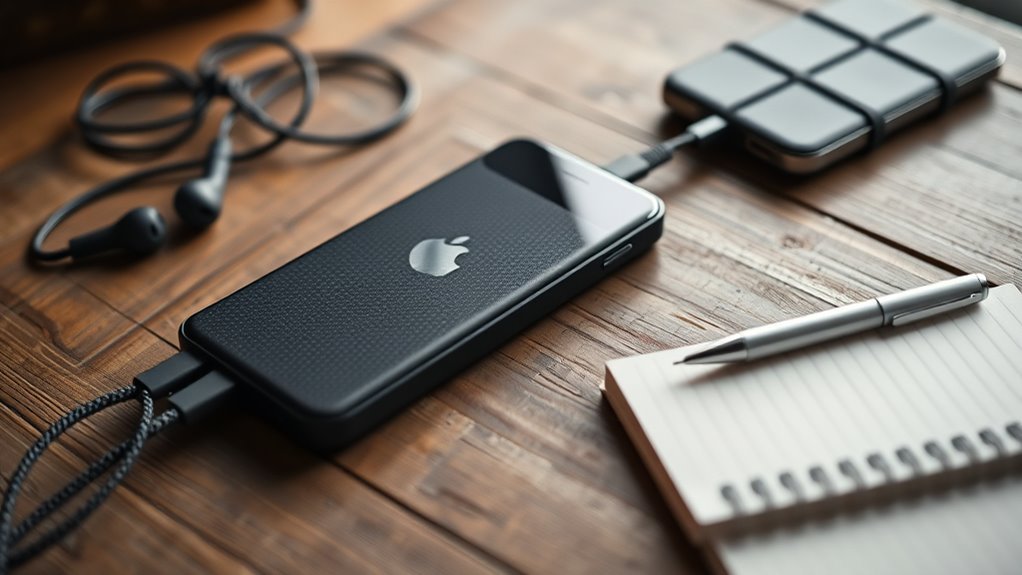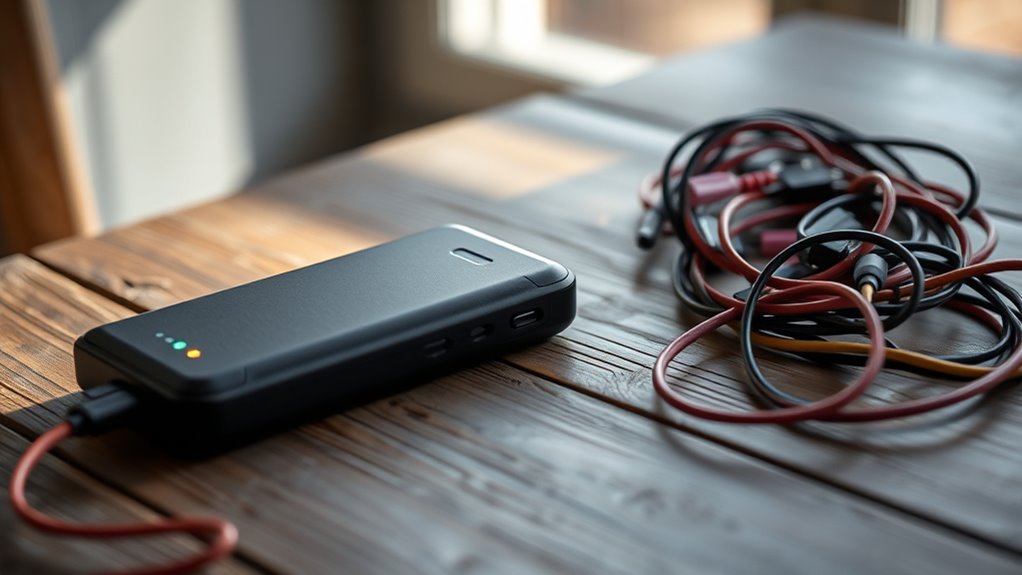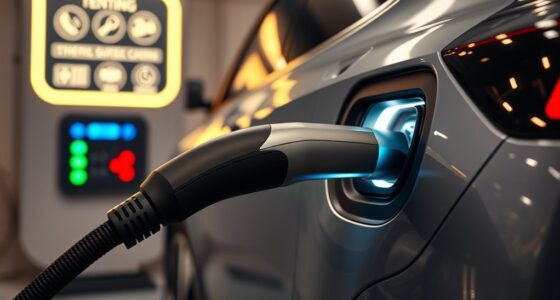During extended outages, having a portable power bank with high capacity is vital to keep your devices running. Look for models with at least 20,000 mAh to recharge phones multiple times or power small gadgets. Solar charging features can boost sustainability and provide extra energy when outlets are scarce, especially outdoors. Recharging speed is also important to minimize downtime. If you want to discover more about selecting the best portable power bank for your needs, keep going.
Key Takeaways
- Choose high-capacity power banks (20,000 mAh or more) for multiple device recharges during extended outages.
- Opt for models with solar charging features to harness renewable energy in prolonged power failures.
- Prioritize fast recharging capabilities to minimize downtime and maximize readiness.
- Consider portability and weight to ensure easy transport during outdoor or emergency situations.
- Ensure the power bank supports multiple device outputs for versatile charging needs.

Have you ever been caught without enough battery when you needed your device most? It’s frustrating, especially during extended outages or when you’re off the grid. That’s where portable power banks come into play, providing a reliable backup to keep your devices alive. When choosing one, you’ll want to consider features like solar charging and battery capacity. Solar charging offers the advantage of recharging your power bank using sunlight, which is ideal during prolonged power failures or outdoor adventures. With solar panels integrated into the power bank, you can harness renewable energy, reducing your dependence on electrical outlets and ensuring your devices stay powered even in remote locations. However, keep in mind that solar charging can be slow, so it’s best used as a supplementary feature rather than the primary method of recharging. battery capacity is another essential factor. It determines how many times your power bank can recharge your devices before needing a recharge itself. If you primarily use your device for basic tasks like calls, texts, or browsing, a smaller capacity—say around 5,000 to 10,000 mAh—may suffice. But if you rely heavily on your device for work, navigation, or streaming, you’ll want a power bank with a larger capacity, perhaps 20,000 mAh or more. This guarantees you won’t run out of power at a critical moment. Remember, larger capacity power banks tend to be heavier and bulkier, so balance your need for power with portability. Some models combine solar charging with high battery capacity, giving you the best of both worlds. These are especially useful for outdoor enthusiasts or during extended outages where access to power is limited. When selecting such a device, check the efficiency of the solar panels—more efficient panels will charge faster and better utilize sunlight. Also, consider how quickly the power bank itself charges when plugged into an outlet, as fast recharging means less downtime before you’re ready to go again.
Frequently Asked Questions
How Do I Maintain My Power Bank for Longevity?
To maintain your power bank’s longevity, you should regularly perform battery maintenance by discharging it partially before recharging. Follow storage guidelines by keeping it in a cool, dry place and avoiding extreme temperatures. Avoid overcharging or leaving it unused for long periods. Keeping your power bank clean and using it regularly helps preserve battery health, ensuring it’s ready when you need it most during extended outages.
Can Portable Power Banks Charge Other Devices Like Laptops?
Yes, portable power banks can charge devices like laptops, but you need to verify device compatibility first. Look for power banks with higher wattage output and USB-C or AC ports designed for laptops. Also, consider charging speed; some power banks charge laptops faster than others. Always confirm if your device is compatible with the power bank’s output to guarantee safe and efficient charging.
What Safety Features Should I Look for in a Power Bank?
When choosing a power bank, you should look for safety features like overcharge protection and battery safety. Overcharge protection prevents your device from damage caused by excessive charging, while battery safety guarantees the power bank itself won’t overheat or short-circuit. These features keep your devices safe and extend the life of your power bank, providing peace of mind during extended outages or everyday use.
Are There Eco-Friendly or Solar-Powered Options Available?
Did you know that solar-powered devices can reduce your carbon footprint by up to 90%? Eco-friendly power banks, especially solar options, are becoming more popular for sustainable living. These eco-friendly power banks harness sunlight to recharge, making them perfect for outdoor activities or extended outages. Investing in solar options guarantees you’re environmentally conscious while keeping your devices charged, reducing reliance on traditional energy sources.
How Do I Calculate the Right Capacity for My Needs?
To find the right capacity for your needs, start with your battery life requirements. Calculate the capacity by estimating how many devices and how much usage time you’ll need, then use capacity calculation formulas to determine the mAh or Wh you should look for. Consider your device’s power consumption, and add a buffer for unexpected usage. This way, you’ll choose a power bank that reliably keeps your devices charged during outages.
Conclusion
Think of your power bank as a trusty lighthouse, guiding your devices safely through the stormy night of an outage. Just as a lighthouse keeps ships afloat and on course, your portable charger ensures your connections stay bright and steady, no matter how long the darkness lasts. Keep it charged and ready—so when the power fades, you’re still sailing smoothly, never lost in the shadows. With this little beacon, you stay connected, no matter what storms come your way.









